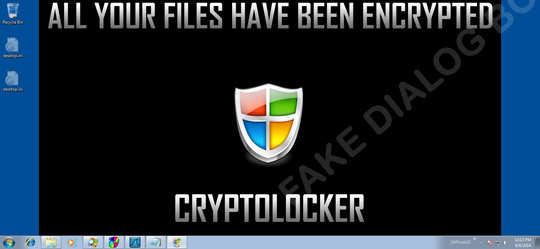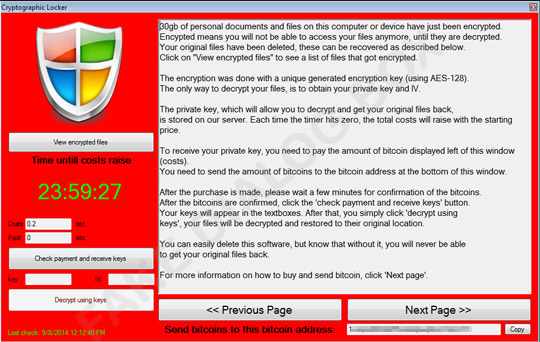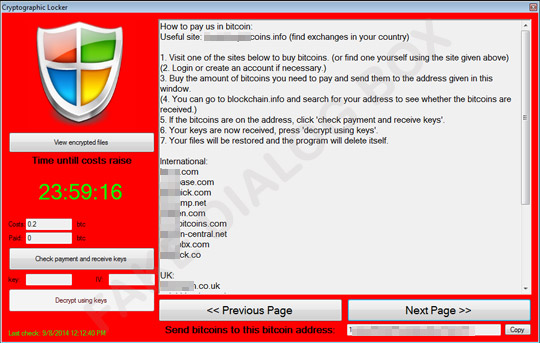TROJ_CRITOLOCK.A
Trojan-Ransom.Win32.Crypren.pzj(Kaspersky), Ransom:MSIL/Glock.A(Microsoft), RDN/Ransom!ej(McAfee), Troj/dnRan-A(Sophos), a variant of MSIL/LockScreen.JV trojan(Eset), Trojan.MSIL.LockScreen(Ikarus)
Windows 2000, Windows Server 2003, Windows XP (32-bit, 64-bit), Windows Vista (32-bit, 64-bit), Windows 7 (32-bit, 64-bit)


Threat Type: Trojan
Destructiveness: No
Encrypted: Yes
In the wild: Yes
OVERVIEW
Dropped by other malware
This Trojan arrives on a system as a file dropped by other malware or as a file downloaded unknowingly by users when visiting malicious sites.
It connects to certain websites to send and receive information.
TECHNICAL DETAILS
140,800 bytes
EXE
Yes
06 Sep 2014
Changes users' wallpaper, Displays message/message boxes
Arrival Details
This Trojan arrives on a system as a file dropped by other malware or as a file downloaded unknowingly by users when visiting malicious sites.
Installation
This Trojan drops the following files:
- {malware path}\filelist.txt - contains list of the original file name of the encrypted files
Autostart Technique
This Trojan adds the following registry entries to enable its automatic execution at every system startup:
HKEY_CURRENT_USER\Software\Microsoft\
Windows\CurrentVersion\Run
CLock = "{malware path and file name}"
Process Termination
This Trojan terminates the following processes if found running in the affected system's memory:
- regedit.exe
- tasmgr.exe
- procexp.exe
- msconfig.exe
- rstrui.exe
Information Theft
This Trojan gathers the following data:
- HWID
- Computer Name
- User Name
Other Details
This Trojan connects to the following website to send and receive information:
- {BLOCKED}ect.no-ip.net
- {BLOCKED}irect.ddns.net
- www.{BLOCKED}zo.nl/modules/tmp/
- www.{BLOCKED}zo.nl/modules/tmp/tmp.dat
It encrypts files with the following extensions:
- .3fr
- .accdb
- .arw
- .bay
- .bmp
- .cdr
- .cer
- .cr2
- .crt
- .crw
- .dbf
- .dcr
- .der
- .dng
- .docm
- .docx
- .doc
- .dwg
- .dxf
- .dxg
- .eps
- .erf
- .exif
- .gif
- .indd
- .jfif
- .jpeg
- .jpg
- .kdc
- .mdb
- .mdf
- .mef
- .mp3
- .mrw
- .nef
- .nrw
- .odb
- .odc
- .odm
- .odp
- .ods
- .odt
- .orf
- .p12
- .p7b
- .p7c
- .pdd
- .pef
- .pem
- .pfx
- .png
- .pptm
- .pptx
- .ppt
- .pptx
- .psd
- .pst
- .ptx
- .r3d
- .raf
- .raw
- .rtf
- .rw2
- .rwl
- .sr2
- .srf
- .srw
- .txt
- .wb2
- .wpd
- .wps
- .x3f
- .xlk
- .xlsb
- .xls
- .xlsm
- .xlsx
It renames encrypted files using the following names:
- {original file name and extension}._clf
NOTES:
After successfully encrypting files on the targeted system, it replaces the wallpaper with another image:



SOLUTION
9.700
11.130.08
05 Sep 2014
11.131.00
06 Sep 2014
Step 1
Before doing any scans, Windows XP, Windows Vista, and Windows 7 users must disable System Restore to allow full scanning of their computers.
Step 2
Note that not all files, folders, and registry keys and entries are installed on your computer during this malware's/spyware's/grayware's execution. This may be due to incomplete installation or other operating system conditions. If you do not find the same files/folders/registry information, please proceed to the next step.
Step 3
Restart in Safe Mode
Step 4
Delete this registry value
Important: Editing the Windows Registry incorrectly can lead to irreversible system malfunction. Please do this step only if you know how or you can ask assistance from your system administrator. Else, check this Microsoft article first before modifying your computer's registry.
- In HKEY_CURRENT_USER\Software\Microsoft\Windows\CurrentVersion\Run
- CLock = "{malware path and file name}"
- CLock = "{malware path and file name}"
Step 5
Search and delete this file
- {malware path}\filelist.txt
Step 6
Restart in normal mode and scan your computer with your Trend Micro product for files detected as TROJ_CRITOLOCK.A. If the detected files have already been cleaned, deleted, or quarantined by your Trend Micro product, no further step is required. You may opt to simply delete the quarantined files. Please check this Knowledge Base page for more information.
Did this description help? Tell us how we did.
